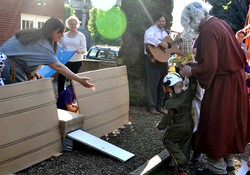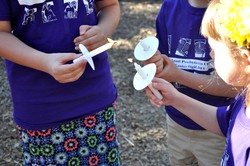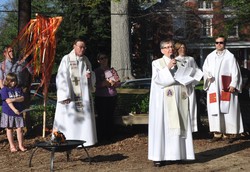Cynthia Campbell still remembers the first time she crossed the Red Sea.
It was in the mid-1980s on the campus of Austin Presbyterian Theological Seminary during the seminary’s first Easter vigil.
Fred Holper, then the seminary’s associate professor of homiletics and liturgics and now retired and married to Campbell, started the tradition at Austin when Campbell was also on the faculty.
“He convinced us to do the service but to really dramatize it,” Campbell recalls. “He convinced us that this is a service that ought to include movement and music and dance and art. It should be both visually as well as intellectually interesting, like most Presbyterian worship.”
And so, beginning in darkness at sunset on the eve of Easter Sunday, the fledgling group of worshipers traipsed all over the seminary campus. As they reached a stream, they remembered and reenacted Israel’s delivery from bondage by reading from the book of Exodus. Then they all crossed to the other side. Courtesy of a bridge.
As she remembered her powerful introduction to the Great Vigil of Easter, Campbell, pastor and head of staff at Highland Presbyterian Church since 2011, decided to approach the church’s worship committee to revive the ancient service.
The liturgy for the vigil, found in the Presbyterian Book of Common Worship, consists of four parts: services of Light, Readings, Baptism and Eucharist. David Gambrell, the Presbyterian Mission Agency’s associate for worship and a teaching elder member whose family worships at Highland, likes to refer to this multifaceted service as “the Swiss Army knife of liturgy,” one service that does many things.
“The whole idea of this service is to experience of the breadth of the story of grace, to listen and sing and dance your way through the sweep of the story,” Campbell says. “We so rarely ever get the whole sweep of the biblical story, and this is the service that does that.”
Highland, which had last done a vigil in the 1990s, embraced the idea. This year marks the church’s fourth Easter vigil.
William McConnell, a ruling elder at Highland and a member of its worship committee, who is also executive director of the Presbyterian Association of Musicians, has been involved in the planning and/or leadership of all of the Easter vigil services since 2013.

Part of the Easter Vigil celebration at Highland Presbyterian involves the retelling of Old Testament stories, including the great flood and Noah's Ark. This also allows for children to participate in the service by boarding the "ark." Children are encouraged to dress in costumes. —Robyn Davis Sekula
“At Highland, the Easter vigil is an intergenerational experience with leadership from children through senior adults,” McConnell says. “Children reenact the story of God's deliverance of Noah and the animals; youth recreate in costume, dance, and lighting Ezekiel’s valley of the dry bones; musicians from the congregation contribute music of varying styles and genres; and the congregation, moving from outdoor playground, through the church building, and finally into the sanctuary, join in the drama with song and spoken word. The boisterous shouts of ‘Alleluia! Christ is risen! He is risen, indeed!’ culminate the procession and lead us into the first service of Easter.”
Adds Campbell, “Our last time in the sanctuary will have been on Good Friday, when the church is as bare as it ever is. When we walk in at the vigil, there will be a couple of new banners and a bunch of white drapery. It will look very different, and that’s the idea. You come back into the space now, and it’s full of light and color.”
Although an Easter vigil can often last up to two and a half hours, with people coming and going, Highland tries to keep the length of its service to about an hour and a half. “That’s especially important this year since there’s a basketball game,” says Campbell. “We’ll get everyone home for tip-off.”

Children and adults light candles at the Easter Vigil. —Robyn Davis Sekula
Even Highland’s slightly abridged vigil will include a sermon by Matt Nickel, one of the church’s associate pastors. “I’m enough of a Presbyterian that you don’t go to the table without proclaiming the Word in some way,” Campbell says.
Campbell can still remember the opening words of the sermon she gave at Austin Seminary’s first Easter vigil: “It’s a long story, isn’t it?”
“It takes a while to tell,” she says. “It’s worth noting that. And it also intentionally puts resurrection in the context of everything else God has done. So God has given us creation; God made a promise to creation in the flood never again to destroy; God saved the people of Israel at the exodus. All of these prefigure resurrection. They’re all the same motion of God’s mighty acts on our behalf. I think that’s an important thing for us to rehearse and remember and experience.”

